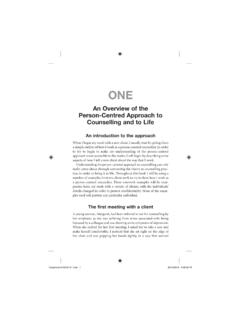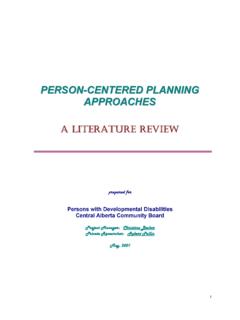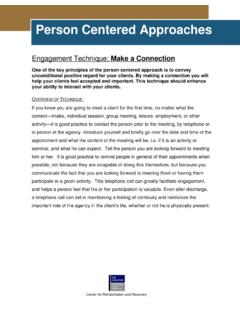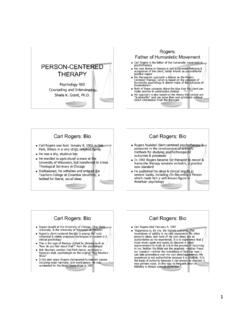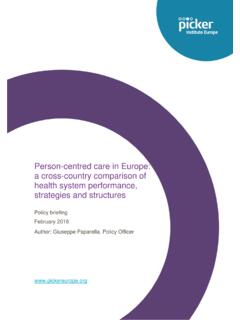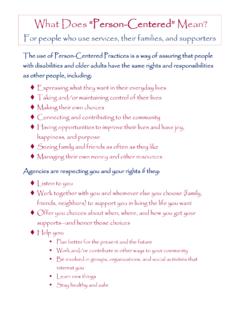Transcription of PERSON-CENTRED NURSING AUTHORS - Liber Läromedel
1 1 PERSON-CENTRED NURSING AUTHORS : Professor Tanya McCance, Co-Director NURSING R&D/Mona Grey Professor of NURSING R&D Belfast HSC Trust/University of Ulster Email: Professor Brendan McCormack Director, Institute of NURSING Research and Head of PERSON-CENTRED Practice Research Centre, Institute of NURSING Research/School of NURSING , University of Ulster Email: 2 Introduction This chapter will explore the theory and practice of PERSON-CENTRED NURSING . An overview of PERSON-CENTRED NURSING will be provided, incorporating an analysis of its evolution into contemporary NURSING practice, policy and strategy.
2 A framework for PERSON-CENTRED NURSING will then be outlined, with each of the constructs and concepts underpinning the framework described. Practical examples of the constructs and related concepts will be provided. We will also underpin the discussion of the constructs and concepts with relevant contemporary research in NURSING and healthcare. Finally we will present a discussion of key considerations in the development of PERSON-CENTRED ways of working for individuals, teams and organisations. A case study of PERSON-CENTRED development will be offered.
3 This project shows how a team in an acute hospital setting attempted to change the culture of their workplace towards one that was more PERSON-CENTRED . The chapter will conclude with key lessons to be considered in the adoption of a PERSON-CENTRED approach to NURSING . The Evolution of Person-centredness Person-centredness is a term that has become increasingly familiar within health and social care at a global level and has been used to describe a standard of care that ensures the patient/client is at the centre of care delivery.
4 It is therefore not surprising that the body of literature relating to PERSON-CENTRED care is growing, and with it increasing academic debate and critical dialogue regarding developments in this field. McCormack (2004) undertook one of the first literature reviews of person-centredness in the context of gerontological NURSING and identified a number of common dimensions of personhood that transcend the variety of models and frameworks that exist. However, more importantly, the review along with others by McCormack et al (2010a) and McCance et al (2011) highlight the limitations of the research into person-centredness thus far: it mostly focuses on attempts to clarify the 3 meaning of the terms personhood and person-centredness (Slater 2006, Edvardsson et al 2010); explores the implications of the terms in practice (Dewing 2004); and determines the cultural and contextual challenges to implementing a PERSON-CENTRED approach (McMillan et al 2010.)
5 McCormack et al 2008, McCormack & McCance 2010b). There has also been significant conceptual and theoretical advancements in the area of person-centredness with the development of frameworks such as the Authentic Consciousness Framework (McCormack 2001), the Senses Framework (Nolan et al 2004) and the PERSON-CENTRED NURSING Framework (McCormack & McCance 2006, 2010) alongside the application and testing of these frameworks in practice (McCormack et al 2010b, McCance et al 2010, Ryan et al 2008). These conceptual and theoretical developments have gone some way to enhancing our understanding of how we can effectively operationalise person-centredness in practice and indeed have helped pave the way towards a greater focus on the development of frameworks and tools for outcome evaluation arising from PERSON-CENTRED approaches (Slater et al 2009, McCormack et al 2010c, Smith et al 2010; Edvardsson & Innes 2010).
6 However the work on outcome evaluation is at an early stage of development and considerable work is needed to develop inclusive methodological approaches that can capture the complexities of PERSON-CENTRED NURSING in practice (McCormack & Heath 2010, ). The Concept of Person-centredness and PERSON-CENTRED NURSING Much of the literature about person-centredness and PERSON-CENTRED practice is currently found within the field of gerontology, initially due to the influences of early writers/researchers such as Tom Kitwood (who focused on PERSON-CENTRED dementia care) (McCormack & McCance 2010).
7 A further focus is that of the origins of person-centredness predominantly from a humanistic psychology perspective (Rogers 1980; Heron 1992). 4 However, the term person-centredness is being used more freely within health and social care strategy, policy and practice and there is a danger that the term is being used in a tokenistic way and without any deep sense of what it means for practice and decision-making. Within NURSING , the concept of person-centredness has had a long association with NURSING theory.
8 Many of the early nurse theorists (such as Dorothy Orem, Sr Callista Roy, Madeleine Leininger, Jean Watson [to name but a few]) whilst not explicitly using the term PERSON-CENTRED , built their theories on concepts of the person , the environment , the nurse and health . Each of these concepts were articulated from particular philosophical perspectives and from these theories, models of NURSING were developed. Whilst these models provided useful frameworks for nurses to focus their practice, in reality many nurses struggled to make sense of them beyond superficial understanding of particular care processes (such as Activities of Daily Living, Self-Care etc).
9 However, building on this strong NURSING tradition of basing care practices on theoretical perspectives, it is no surprise then that PERSON-CENTRED NURSING has evolved a similar tradition, but without allegiance to a particular world-view. Instead, PERSON-CENTRED NURSING is an adaptation and application of concepts of personhood, person-centredness and PERSON-CENTRED care in a NURSING context. Taking account of these developments and a review of the PERSON-CENTRED literature (McCormack 2004), McCormack et al (2010b) offer a definition of person-centredness, which is consistent with understandings of person-centredness in a NURSING context: Person-centredness is an approach to practice established through the formation and fostering of therapeutic relationships between all care providers, patients and others significant to them in their lives.
10 It is underpinned by values of respect for persons , individual right to self determination, mutual respect and 5 understanding. It is enabled by cultures of empowerment that foster continuous approaches to practice development (McCormack et al 2010b, P13) Further, McCormack (2004) argues that there are four core concepts at the heart of PERSON-CENTRED NURSING : being in relation, being in a social world, being in place and being with self. Being in relation emphasises the importance of relationships and the interpersonal processes that enable the development of relationships that have therapeutic benefit.



